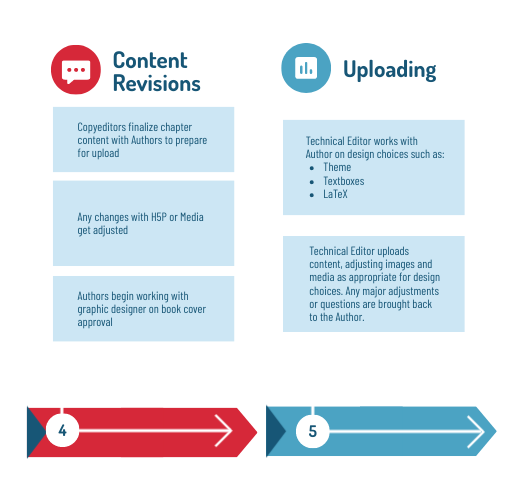Multimedia
Our Multimedia Specialist worked in an overlap position with the Copy-Editors and the Technical Editor. The goal was to spend content revision time working with the author to brainstorm methods of incorporating media (audios, videos, images, HTML 5 Package (H5P)), and then work with the Technical Editor to ensure that each piece was put into the book correctly.

Images
As explained to authors in the Media Options section of the Options Presentation, images adhere to specific requirements for inclusion.
Alternative Text
Standard Policy
Each image in a ROTEL Project work required alternative text (alt-text), even if it was simply to add “decorative,” when the image was contributing only decoration rather than a substantive image. Alt-text was reviewed to ensure that the purpose of the image within the context of the text was reflected.
Rationale
This is standard best-practice for web publishing for accessibility.
Lessons Learned
Alt-Text Drafting: Authors who are involved in the writing of their content may easily forget to include alt-text. This meant we would have to go back over these images with the authors. We tried to avoid drafting the text ourselves, since we are not the Subject Matter Experts (SMEs), and the context of the image is important.
- For example, the same image of a child could have very different relevance for a book about child development as opposed to a book covering genetics.
This would sometimes come up against the time constraints of the authors, and it would be difficult for the authors to find the time to review the images and develop alt-text drafting language. This became a bit of a roadblock. Our brainstormed solution was to provide a form cataloguing all images used in a project with a field for alt-text drafting.
Audios & Videos
Standard Policy
As explained to authors in the Media Options section of the Options Presentation, audio and video adhere to specific requirements for inclusion.
Rationale
The PST kept similar best-practice methods regarding media to ensure that we maintained a high level of integrity with our source material. We also go the extra mile to ensure that used media are accessible to all. At times, this can be challenging and time consuming, and we would like to thank the authors for their understanding and continued support.
Lessons Learned
Source Material Changes: Many of the audios and videos used originated from external sources through the embedding method (i.e., YouTube). One of the disadvantages for our authors is the risk of losing access to these media if they are ever removed. We did experience this scenario during the content migration with a few books and PST helped the authors find and replace with accessible ones.
HTML5 Package
As explained to authors in the Media Options section of the Options Presentation, HTML5 Package (H5P) inclusion adheres to specific requirements for inclusion.
Rationale
Mission Oriented: The use of H5P activities in the web version of books will enhance the learning experience for the readers. To stay true to our mission, all our H5P activities are downloadable and embeddable for reuse or modification.
Lessons Learned
Ease of Use: Due to the initial high learning curve, only a small number of our authors attempted to learn and use H5P on their own. Therefore, most H5P activities were created by the PST. This will limit future use of H5P for the authors once the PST is no longer available. Authors have been encouraged to reach out to their local support team for future assistance.

